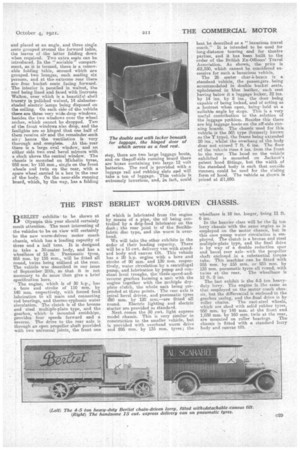THE FIRST BERLIET WORM-DRIVEN CHASSIS._
Page 17

If you've noticed an error in this article please click here to report it so we can fix it.
BERLIET exhibits to be shown at Olympia this year should certainly merit attention. The most interesting of the vehicles 'to 'be on view will certainly 'be the new worm-driven motor coach chassis, which has a loading capacity of three and a half tons. It is designed to take a 30-seater body, and has a wheelbase of 15 ft. Pneumatic tyres, 955 mm. by 155 mm., will be fitted all round, twins being utilized at the rear. The vehicle was described in our issue of September 20th, so that it is not necessary to do more than give a brief specification here. The engine, which is of 30 h.p., has a bore and stroke of 110 mm. by 140 mm. respectively, with forced feed lubrication to all main and connecting rod bearings, and therrno-syphonic water circulation. The clutch is of the bronze and steel multiple-plate type, and the gearbox, which is mounted amidships, provides four speeds forward and a reverse. The drive to the rear axle is through an open propeller shaft provided with two universal joints, the front one
of which is lubricated from the engine by means of a pipe, the oil being controlled by a drip-feed lubricator on the dash; the rear joint is of the flexiblefabric disc type, and the worm is overhead.
We will take the other exhibits in the drder of their loading capacity. There will be a 15 cwt. delivery van with standard body and canvas tilt. This vehicle has a 20 h.p. engine with a bore and stroke of 90 mm. and 130 mm. respectively, water circulation by a centrifugal pump, and lubrication by pump and constant level troughs, the three-speed-and'reverse gearbox forming a unit with the engine together with the multiple dryplate clutch, the whole unit being suspended at three points. The rear axle is spiral -bevel driven, and pneumatic tyres 880 mm. by 120 mm.—are fitted all round. Electric lighting and electric starter are provided as standard. Next Comes the 30 cwt. light express model chassis. This is very similar in construction to the smaller vehicle, but is provided with overhead worm drive and 895 mm. by 135 mm. tyres; the wheelbase is 18 ins, longer, being 11 ft. 6 ins.
In the heavier class will be the 21ton lorry chassis with the same engine as is employed on the motor chassis, but in this case pump water circulation is employed. The clutch is a bronze and steel multiple-plate. type, and the final drive is by way of a double reduction spur and bevel rear axlewith the propeller shaft enclosed in a substantial torque tube. This machine can be fitted with 955 mm. by 155 mm. or 935 mm. by 135 mm. pneumatic tyres all round, with
twins at the rear. The wheelbase is 12 ft. 8 ins.
The last, exhibit. is the 4-5 ton heavyduty lorry. The engine is the same as that employed on the motor coach chassis, but the differential is enclosed in the gearbox casing, and the-final drive is by
roller chains. The cast-steel wheels, which are shod with solid rubber tyres, 950 mm. by 140 aim. a the front and 1,030 mm. by 160 mm. twin at the rear, are mounted on roller bearings. The chassis is fitted with a standard lorry body and canvas tilt.
















































